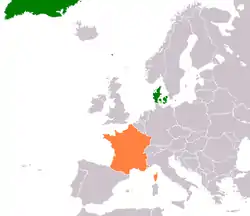 | |
Denmark |
France |
|---|---|
Denmark–France relations are the current and historical relations between Denmark and France. Denmark has an embassy in Paris and France has an embassy in Copenhagen. Both countries are full members of the Council of Europe, the European Union and NATO.[1][2]
History
The relations between Denmark and France date back to the Dark ages, when Danish Vikings pillaged the Northern part of the country, including Paris which Ragnar Lodbrok and his army sacked in the 845. Paris was again attacked in 885 and 886 by Vikings. They settled Northern France, becoming the Normans, who conquered England in 1066. When Scandinavia Christianized, French monks lived in Denmark, and Danish students in Paris. In the 17th century, there were many Danish students in medicine, law, philosophy and theology in France, while in Denmark there were many French tutors.[3]
Ingeborg, daughter of Valdemar I of Denmark, was queen consort of France (1193 & 1200-1223).
Scanian War

The Scanian War (1675-1679) was a part of the Northern Wars involving the union of Denmark-Norway, Brandenburg and Sweden. It was fought mainly on Scanian soil, in the former Danish provinces along the border with Sweden and in Northern Germany. While the latter battles are regarded a theater of the Scanian war in English, Danish and Swedish historiography, they are seen as a separate war in German historiography, called the Swedish-Brandenburgian War.
The war was prompted by the Swedish involvement in the Franco-Dutch War. Sweden had allied with France against several European countries. The United Provinces, under attack by France, sought support from Denmark-Norway. After some hesitation, King Christian V started the invasion of the Scania (Skåneland) in 1675, while the Swedish were occupied with a war against Brandenburg. The invasion of Scania was combined with a simultaneous Norwegian front called the Gyldenløve War, forcing the defending Swedes to fight a two-front war in addition to their entanglements in the Holy Roman Empire.
The Danish objective was to retrieve the Scanian lands that had been ceded to Sweden in the Treaty of Roskilde, after the Northern Wars. Although the Danish offensive was initially a great success, Swedish counter-offensives led by the 19-year-old Charles XI of Sweden nullified much of the gain.
It was a war with no definite victor; the Swedish navy lost at sea, the Danish army was defeated in Scania by the Swedes, who in turn were defeated in Northern Germany by the Brandenburgers. The war and the hostilities ended when Denmark's ally the United Provinces settled with Sweden's stronger ally France and the Swedish king Charles XI married Danish princess Ulrike Eleonora, sister of Christian V. Peace was made on behalf of France with the treaties of Fontainebleau and Lund and Saint Germain, restoring most of the lost territories to Sweden.[4]
War of the Sixth Coalition
In the War of the Sixth Coalition (1812–1814), a coalition of Austria, Prussia, Russia, Spain, Sweden, the United Kingdom, and a number of German States finally defeated France and drove Napoleon Bonaparte into exile on Elba. After Napoleon's disastrous invasion of Russia, the continental powers joined Russia, Britain, Portugal and the rebels in Spain. With their armies reorganized along more Napoleonic lines, they drove Napoleon out of Germany in 1813 and invaded France in 1814, forcing Napoleon to abdicate and restoring the Bourbons.
Economic relations
French exports to Denmark were 2.19 billion euros in 2009. Imports from Denmark were 2.35 billion euros in 2009.[5]
See also
Notes and references
- ↑ Danish Embassy in Paris Archived 2010-10-02 at the Wayback Machine (in Danish) [ (in French)
- ↑ French Embassy in Copenhagen Archived 2017-03-21 at the Wayback Machine (in Danish and French)
- ↑ The German Influence in Danish Literature. p. 211. ISBN 9781001287843. Archived from the original on 2022-03-27. Retrieved 2011-01-04.
- ↑ The Scanian War 1675-79 Archived 2007-09-27 at the Wayback Machine. Educational site for high schools created by Oresundstid Archived 2007-09-27 at the Wayback Machine.
- ↑ "Economic relations". Archived from the original on 2011-06-22. Retrieved 2011-01-06.
